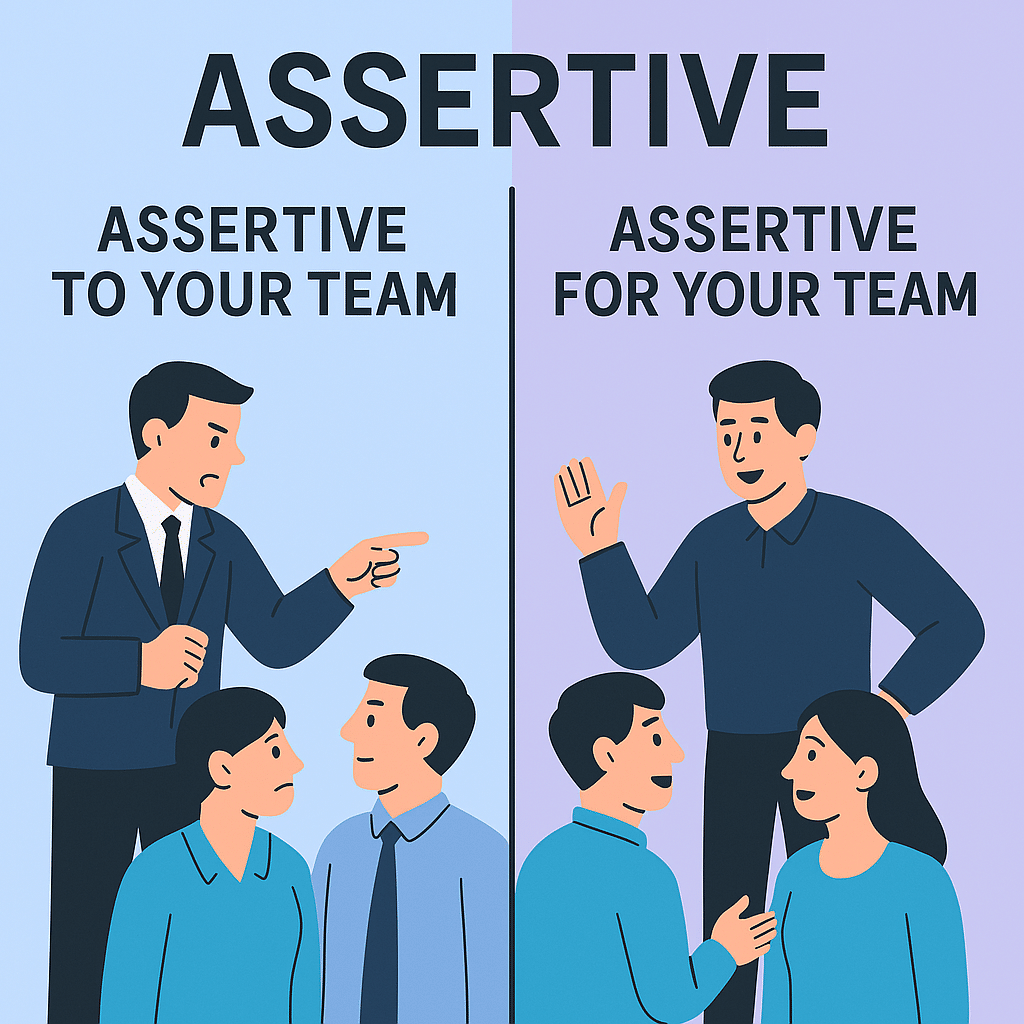Being Assertive to Your Team vs. Being Assertive for Your Team
In the high-stakes world of executive leadership, how CEOs interact with their leadership teams can make or break an organization’s success. Many CEOs struggle with finding the right balance of assertiveness—push too hard, and you risk creating a culture of fear and compliance; be too passive, and decisions stall while accountability fades.
The key distinction that separates truly transformative leaders from merely effective managers lies in understanding the difference between being assertive to your team versus being assertive for them. See below:
| Assertive To Your Team | Assertive For Your Team’s Growth | |
|---|---|---|
| Mindset | “I need to be in control.” Driven by fear of failure or losing authority Measures success by compliance Worried about what others might think about you | “I want them to step into leadership.” Driven by trust in people’s growth potential Measures success by ownership and initiative Sees assertiveness as a gift to their people’s growth |
| Communication Style | Directive: “Do this now.” Corrects mistakes immediately Talks at the team | Ask questions supportively: “What’s your approach?” Creates space for reflection and learning Talks with the team, listens deeply |
| Conflict & Accountability | Blames or points fingers Uses pressure to drive results Reacts emotionally to errors | Holds space for difficult conversations with care Uses clarity and agreements to foster accountability Responds by coaching through the issue |
| Long-Term Impact | Creates dependency on you Limits innovation & experimentation Exhausts you & bottlenecks scale | Builds leaders who operate without you Encourages ownership and initiative Frees you to lead the company forward |
Assertive TO your team
This approach positions the CEO and their leadership team in a subtle but problematic dynamic:
- The CEO pushes for results and compliance
- Team members focus on meeting expectations rather than solving core problems
- Executives filter information to align with what they think the CEO wants to hear
- The CEO receives incomplete or sanitized information
- Strategic decisions suffer from limited perspective and insufficient challenge
- The cycle continues, reinforcing superficial alignment rather than genuine commitment
This dynamic creates fundamental organizational tension. Senior leaders sense they’re being directed rather than developed, managed rather than led. Even when they verbally commit to initiatives, their internal commitment may be lacking, leading to what looks like agreement in meetings but manifests as delayed implementation afterward.
When CEOs are assertive TO their teams in this manner, they:
- Generate compliance without commitment
- Create environments where people manage up rather than speak truth
- Discourage the healthy conflict necessary for optimal decisions
- Receive superficial agreement followed by passive resistance
- Foster a culture where meetings result in vague action items rather than clear decisions
Being Assertive For Your Team
The alternative approach—being assertive for your leadership team—fundamentally reframes the relationship and purpose of executive interactions. This mindset sees the CEO’s primary responsibility not as directing outcomes but as creating conditions for clear decisions, genuine commitment, and leadership development.
When a CEO is assertive for their team, they:
- Challenge indecision and avoidance patterns: By refusing to accept vague commitments or endless analysis, they help executives break through organizational inertia and personal risk aversion.
- Demand clarity rather than specific outcomes: The goal isn’t to force agreement with the CEO’s preferred solution but to eliminate the middle ground of “maybe” that keeps organizations stuck.
- Hold leaders accountable to their own stated values and goals: If an executive has committed to certain priorities or principles, the CEO reminds them of these commitments when conflicting behaviors emerge.
- Force organizational truth-telling: By asking penetrating questions, they help the leadership team confront uncomfortable realities rather than hiding behind comfortable narratives.
- Provide structure for consequential decision-making: Many leadership teams struggle with decisions not because they lack information but because they lack frameworks for evaluation and the courage to commit to difficult choices.

The Distinction in Practice
1. Detailed questioning about implementation plans rather than making judgements
Rather than accepting “We’ll look into it” or “We’ll report back next quarter,” the CEO who is assertive for their team asks:
- “What specifically will you be doing between now and our next meeting?”
- “What metrics will tell us whether this approach is working?”
- “What obstacles do you anticipate, and how will you address them?”
- “When exactly will key milestones be reached?”
- “How will you communicate progress to the rest of the organization?”
These questions aren’t designed to micromanage but to create clarity and structure around execution.
2. Challenging unnecessary delays in decision-making with curiosity instead of blame
When an executive suggests an extended timeframe for making a strategic decision, the CEO might ask:
- “You mentioned needing another month for analysis. What specific information will that additional time provide?”
- “We’ve been discussing this issue for the past three quarters. What is preventing us from deciding today?”
- “If we truly believe this is the right strategic direction, why would we delay implementation by six weeks?”
These challenges aren’t about rushing decisions but about exposing organizational patterns of avoidance that keep companies from necessary action.
3. Explicit acknowledgment of team and organizational patterns
A CEO being assertive for their leadership team might say:
- “I notice we’ve had this same conversation in our last three quarterly reviews. What’s really preventing us from moving forward?”
- “Do you recognize that the hesitation we’re seeing reflects the same pattern that delayed our last major initiative?”
- “Would you agree that our collective tendency to seek perfect information has cost us market opportunities in the past?”
This approach helps leadership teams see their own behavioral and decision-making patterns more clearly.
4. Forcing explicit choice helps grow others as leaders
Perhaps most powerfully, being assertive for a leadership team means requiring them to make explicit choices between clear alternatives:
- “We have two options: commit fully to this market entry strategy with all its risks, or explicitly decide to focus elsewhere. Which are we choosing today?”
- “I need a clear decision: either we’re restructuring this division now, or we’re consciously deciding to maintain the current structure despite its challenges.”
- “There’s no middle ground here. Either we’re going to invest at the level required for success, or we’re going to exit this business. Which is it?”
This isn’t dictatorial—it’s clarifying. It forces leadership teams to confront the reality that not deciding is itself a decision with consequences.
5. Distinguishing between dialogue and decision
CEOs who are assertive for their teams clearly delineate when conversations are exploratory versus when they require resolution:
- “We’re in exploration mode for the next 30 minutes. All ideas are welcome without judgment.”
- “We’re now shifting to decision mode. We need to leave this room with a clear choice.”
- “This topic requires a decision today. If we can’t reach consensus in the next hour, I’ll make the call, but I’d prefer we arrive there together.”
This clarity about conversation mode prevents the common pattern of endless discussion without resolution.
The Results of This Shift
When CEOs master the art of being assertive for their teams rather than to them, several transformative organizational shifts occur:
- Decision velocity increases dramatically: Issues that previously cycled through multiple meetings reach resolution in a single discussion.
- Implementation improves: When leaders make clear, specific commitments in front of peers, follow-through improves dramatically.
- Strategic clarity emerges: By forcing explicit choices between competing priorities, the organization develops sharper focus.
- Leadership capacity expands: Team members develop greater decision-making confidence and skill through the CEO’s modeling.
- Organizational politics decrease: When ambiguity is eliminated, the space for political maneuvering shrinks.
The Cultural Dimension
Being assertive for your team rather than to them transforms organizational culture in profound ways:
- Truth-telling becomes normalized: When the CEO consistently demands clarity, honesty gradually displaces political calculation.
- Respect for leadership deepens: Leaders who challenge their teams to be their best selves, even when uncomfortable, earn deeper respect than those who manage through authority alone.
- Psychological safety paradoxically increases: Though the conversations may be more challenging, executives feel safer knowing where they stand and what’s expected.
- Decision ownership becomes distributed: When leaders make clear commitments of their own volition (even if prompted), they take ownership of outcomes rather than merely executing the CEO’s will.
- Organizational maturity accelerates: The entire leadership system develops greater capacity for handling complexity and ambiguity when clarity of process is demanded.
Implementing the Shift
For CEOs looking to make this crucial shift from being assertive to their teams to being assertive for them:
- Examine your relationship with control: Can you genuinely focus on decision quality and clarity rather than directing specific outcomes?
- Develop comfort with tension: Practice maintaining productive discomfort in meetings rather than relieving tension prematurely.
- Master the art of powerful questions: Learn to ask questions that reveal underlying assumptions and force clarity rather than questions that lead to predetermined answers.
- Recognize that your attention is your most powerful tool: What you consistently ask about and focus on will shape your organization more than what you direct.
- Lead through curiosity rather than certainty: Position yourself as the chief question-asker rather than the chief answer-provider.
The Broader Impact
This leadership approach extends far beyond the executive suite. When CEOs model being assertive for rather than to their teams:
- The pattern cascades: Senior leaders begin using similar approaches with their own teams.
- Organizational decision-making improves at all levels: The clarity and commitment modeled at the top becomes the standard throughout.
- Talent retention strengthens: High performers are drawn to environments where clarity and decisive action are valued.
- Strategic execution accelerates: The gap between decision and implementation narrows dramatically.
- Innovation thrives: When leaders know that clear decisions will be made and supported, they’re more willing to propose bold ideas.
The distinction between being assertive to versus for your leadership team may appear subtle, but its organizational impact is profound.
By shifting from a posture of directing outcomes to one of demanding clarity and commitment, CEOs transform from perceived taskmasters to developmental catalysts. They help their leadership teams break through their own avoidance patterns while establishing the conditions for truly distributed leadership.
In an era of unprecedented complexity and rapid change, this approach cuts through organizational noise and politics. It respects leaders’ agency while refusing to enable the indecision that keeps organizations stuck. And it creates the foundation for authentic executive teams based on truth-telling rather than impression management—a foundation that serves both immediate business outcomes and long-term organizational health.
